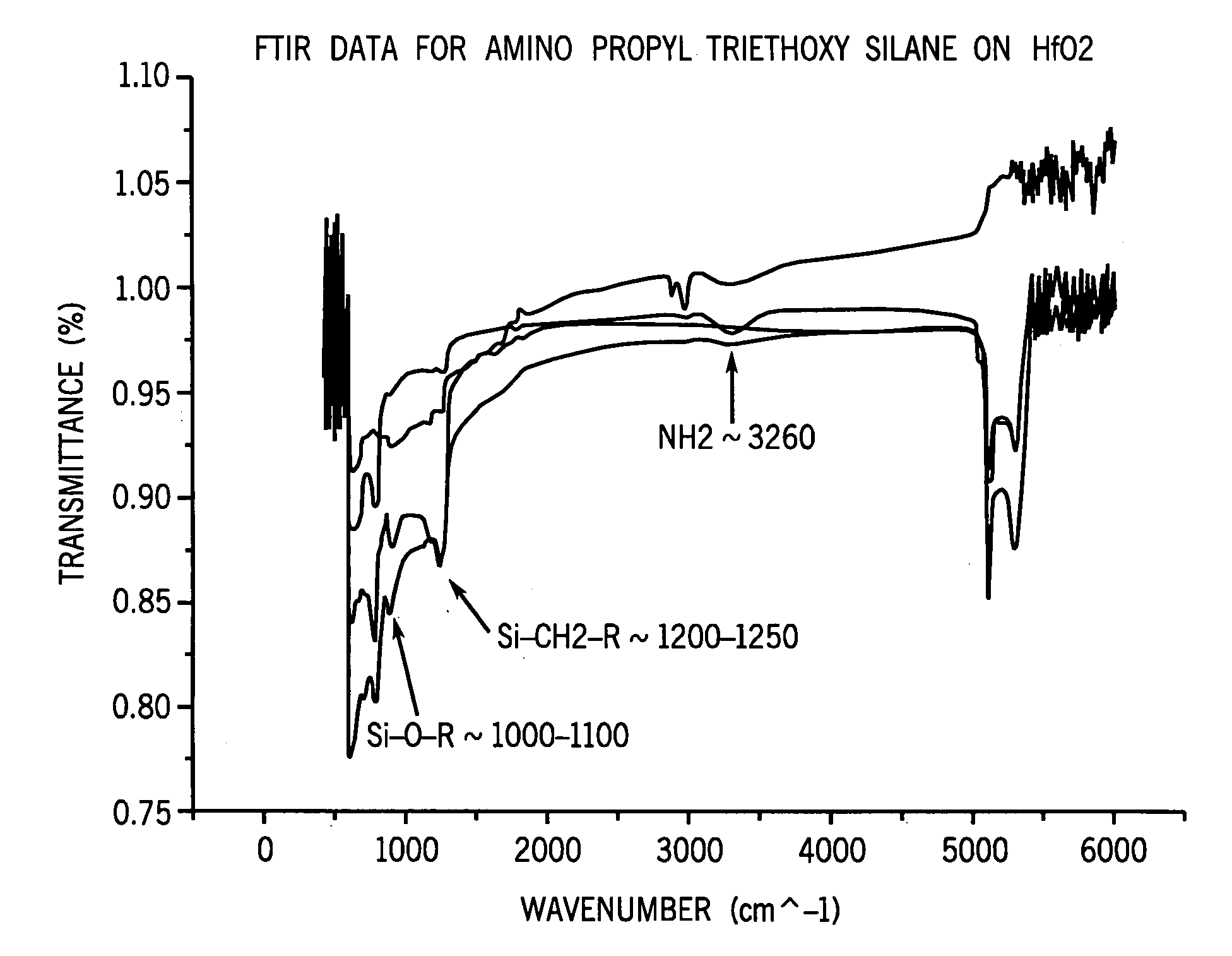Molecular modifications of metal/dielectric interfaces
a technology of dielectric interface and metal, which is applied in the direction of semiconductor devices, electrical apparatus, nanotechnology, etc., can solve the problems of non-zero values of eot/sub>gate, change in the effective sub>m/sub> of metals, etc., and achieve the effect of improving the electrical characteristics of mim or mis structures
- Summary
- Abstract
- Description
- Claims
- Application Information
AI Technical Summary
Benefits of technology
Problems solved by technology
Method used
Image
Examples
example 2
[0024] The binding of SAMs on an oxide surface was confirmed by using Fourier-transform infrared spectroscopy (FTIR). Shown in FIG. 1 are FTIR spectra of APTES deposited on ALD-HfO2 of three different thicknesses, 40 Å, 60 Å, and 90 Å. FIG. 1 also shows a reference FTIR spectrum of a bare ALD-HfO2 surface. The arrows indicate the vibrational energy levels for the important bonds: NH2 (3260 cm−1), Si—(CH2)3(1200-1250 cm−1), and Si—O—C2H5 (1000-1100 cm−1).
[0025] In order to estimate the work-function of an aluminum (Al) electrode, the equivalent oxide thickness (EOT) and the flat-band voltage (VFB) were calculated from C-V plots in the Al / SAM / HfO2 / SiO2 / p+-Si configuration for different thicknesses of ALD-HfO2. FIG. 2 illustrates the plots of VFB versus EOT before and after modification of the AL / HfO2 interface by SAM. The slope of the fitted linear-line corresponds to a fixed-charge density (Nf). If it were assumed that Nf is located at SiOx / Si interface, the intercept corresponds to...
example 3
[0026] A method commonly known as silanization was used to deposit SAM onto thermal SiO2 / Si surfaces with a 4 nm SiO2 thickness (tSiO2); followed by Ti metal top-electrode deposition by e-beam evaporation. With saturated surface coverage of SAM, the φm of Ti was determined through capacitance-voltage (C-V) analysis. The binding of SAM on SiO2 was confirmed by using Fourier-transform infrared spectroscopy (FTIR) and surface coverage of SAM was determined by the change in VFB with deposition time.
[0027] Substrate Preparation: The SiO2 layers (with a thickness tSiO2 of 4, 6, and 8 nm) were deposited on Si by a thermal oxidation process at International Sematech (Austin, Tex.). Prior to the deposition of SAM, the removal of organic deposits on these SiO2 / Si wafers was carried out by rapid thermal annealing (RTA) at 350° C. for 1 minute using a AG Associates (San Jose, Calif.) Heat Pulse 610, followed by sonication with 70% isopropyl alcohol (in water) for 30 sec and then with acetone f...
PUM
 Login to View More
Login to View More Abstract
Description
Claims
Application Information
 Login to View More
Login to View More - R&D
- Intellectual Property
- Life Sciences
- Materials
- Tech Scout
- Unparalleled Data Quality
- Higher Quality Content
- 60% Fewer Hallucinations
Browse by: Latest US Patents, China's latest patents, Technical Efficacy Thesaurus, Application Domain, Technology Topic, Popular Technical Reports.
© 2025 PatSnap. All rights reserved.Legal|Privacy policy|Modern Slavery Act Transparency Statement|Sitemap|About US| Contact US: help@patsnap.com



